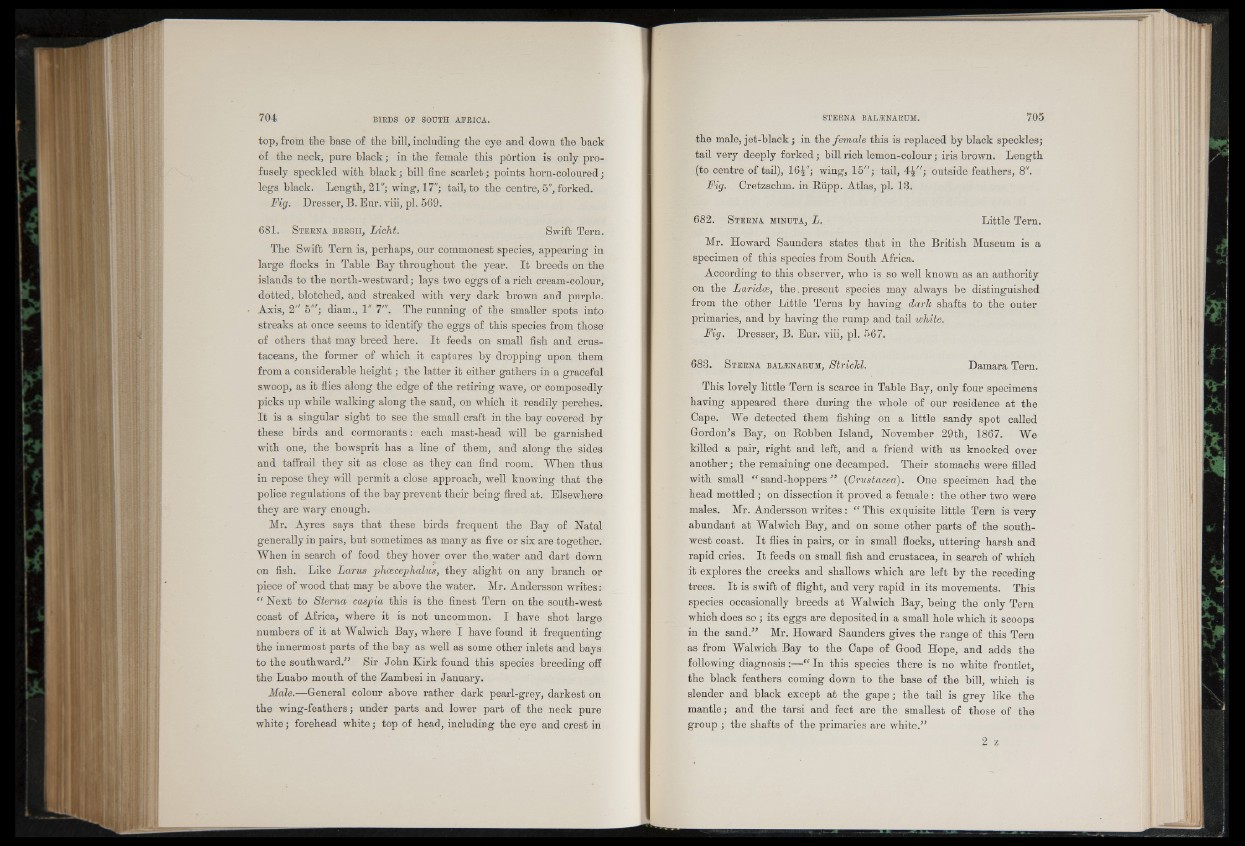
top, from the base of the bill, including the eye and down the back
of the neck, pure black; in the female this portion is only profusely
speckled with black; bill fine scarlet; points horn-coloured;
legs black. Length, 21"; wing, 17"; tail, to the centre, 5", forked.
Fig. Dresser, B. Enr. viii, pi. 569.
681. S terna b e r g ii, Licht. Swift Tern.
The Swift Tern is, perhaps, our commonest species, appearing in
large flocks in Table Bay throughout the year. It breeds on the
islands to the north-westward; lays two eggs of a rich cream-colour,
dotted, blotched, and streaked with very dark brown and purple.
Axis, 2" 5'"; diam., 1" 7/". The running of the smaller spots into
streaks at once seems to identify the eggs of this species from those
of others that may breed here. I t feeds on small fish and crustaceans,
the former of which it captures by dropping upon them
from a considerable height; the latter it either gathers in a graceful
swoop, as it flies along the edge of the retiring wave, or composedly
picks up while walking along the sand, on which it readily perches.
It is a singular sight to see the small craft in the bay covered by
these birds and cormorants: each mast-head will be garnished
with one, the bowsprit has a line of them, and along the sides
and taffrail they sit as close as they can find room. When thus
in repose they will permit a close approach, well knowing that the
police regulations of the bay prevent their being fired at. Elsewhere
they are wary enough.
Mr. Ayres says that these birds frequent the Bay of Natal
generally in pairs, but sometimes as many as five or six are together.
When in search of food they hover over the.water and dart down
on fish. Like Larus phcecephalus, they alight on any branch or
piece of wood that may be above the water. Mr. Andersson writes:
“ Next to Sterna caspia this is the finest Tern on the south-west
coast of Africa, where it is not uncommon. I have shot large
numbers of it at Walwich Bay, where I have found it frequenting
the innermost parts of the bay as well as some other inlets and bays
to the southward.” Sir John Kirk found this species breeding off
the Luabo mouth of the Zambesi in January.
Male.—General colour above rather dark pearl-grey, darkest on
the wing-feathers; under parts and lower part of the neck pure
white; forehead white; top of head, including the eye and crest in
the male, jet-black; in the female this is replaced by black speckles;
tail very deeply forked; bill rich lemon-colour; iris brown. Length
(to centre of tail), 16|"; wing, 15"; tail, 4 |" ; outside feathers, 8".
Fig. Cretzschm. in Rupp. Atlas, pi. 18.
682. S t e r n a minuta, L. Little Tern.
Mr. Howard Saunders states that in the British Museum is a
specimen of this species from South Africa.
According to this observer, who is so well known as an authority
on the Laridce, the. present species may always be distinguished
from the other Little Terns by having darlc shafts to the outer
primaries, and by having the rump and tail white.
Fig. Dresser, B. Eur. viii, pi. 567.
683. S t e r n a b a m n a r um , Strickl. Damara Tern.
This lovely little Tern is scarce in Table Bay, only four specimens
having appeared there during the whole of our residence at the
Cape. We detected them fishing on a little sandy spot called
Gordon’s Bay, on Robben Island, November 29th, 1867. We
killed a pair, right and left, and a friend with us knocked over
another; the remaining one decamped. Their stomachs were filled
with small “ sand-hoppers ” (Crustacea). One specimen had the
head mottled; on dissection it proved a female: the other two were
males. Mr. Andersson writes : “ This exquisite little Tern is very
abundant at Walwich Bay, and on some other parts of the southwest
coast. It flies in pairs, or in small flocks, uttering harsh and
rapid cries. It feeds on small fish and Crustacea, in search of which
it explores the creeks and shallows which are left by the receding
trees. It is swift of flight, and very rapid in its movements. This
species occasionally breeds at Walwich Bay, being the only Tern
which does so ; its eggs are deposited in a small hole which it scoops
in the sand.” Mr. Howard Saunders gives the range of this Tern
as from Walwich. Bay to the Cape of Good Hope, and adds the
following diagnosis:—I In this species there is no white frontlet,
the black feathers coming down to the base of the bill, which is
slender and black except at the gape; the tail is grey like the
mantle; and the tarsi and feet are the smallest of those of the
group ; the shafts of the primaries are white.”